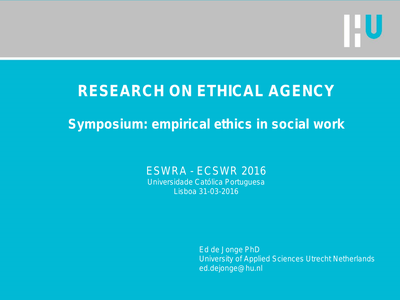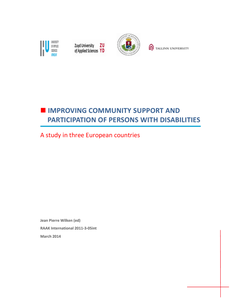Parental involvement is a crucial force in children’s development, learning and success at school and in life [1]. Participation, defined by the World Health Organization as ‘a person’s involvement in life situations’ [2] for children means involvement in everyday activities, such as recreational, leisure, school and household activities [3]. Several authors use the term social participation emphasising the importance of engagement in social situations [4, 5]. Children’s participation in daily life is vital for healthy development, social and physical competencies, social-emotional well-being, sense of meaning and purpose in life [6]. Through participation in different social contexts, children gather the knowledge and skills needed to interact, play, work, and live with other people [4, 7, 8]. Unfortunately, research shows that children with a physical disability are at risk of lower participation in everyday activities [9]; they participate less frequently in almost all activities compared with children without physical disabilities [10, 11], have fewer friends and often feel socially isolated [12-14]. Parents, in particular, positively influence the participation of their children with a physical disability at school, at home and in the community [15]. They undertake many actions to improve their child’s participation in daily life [15, 16]. However, little information is available about what parents of children with a physical disability do to enable their child’s participation, what they come across and what kind of needs they have. The overall aim of this thesis was to investigate parents’ actions, challenges, and needs while enhancing the participation of their school-aged child with a physical disability. In order to achieve this aim, two steps have been made. In the first step, the literature has been examined to explore the topic of this thesis (actions, challenges and needs) and to clarify definitions for the concepts of participation and social participation. Second, for the purposes of giving breadth and depth of understanding of the topic of this thesis a mixed methods approach using three different empirical research methods [17-19], was applied to gather information from parents regarding their actions, challenges and needs.
DOCUMENT

Students’ health profession education includes learning at the workplace through placements. For students, participating in daily work activities in interaction with supervisors, co-workers and peers is a valuable practice to learn the expertise that is needed to become a health care professional. To contribute to the understanding of HPE-students’ workplace learning, the focus of this study is to identify affordances and characterise student’s participation during placements. We applied a research design based on observations. Three student-physiotherapists and four student-nurses were shadowed during two of their placement days. A categorisation of affordances is provided, in terms of students’ participation in activities, direct interactions and indirect interactions. Students’ daily participation in placements is discussed through unique combinations and sequences of the identified affordances reflecting changing patterns over time, and differences in the degree of presence or absence of supervisors, co-workers and peers.
LINK
This article describes a European project which was aimed at improving the situation of persons with psychiatric or learning disabilities with regard to social participation and citizenship. The project took place in three countries (Estonia, Hungary and the Netherlands) and four cities (Tallinn, Budapest, Amersfoort and Maastricht). The project included research and actions at the policy level, the organizational level and the practice level. At the policy level, the framework of the United Nations Convention on the Rights of Persons with Disabilities (United Nations, 2006) and the European Disability Strategy (European Commission, 2010) were used to look at national and local policies, at the reality of the lives of those with disabilities and at the support that professional services offer with regard to participation and inclusion. The project generated a number of insights, recommendations and methods by which to improve the quality of services and increase the number of opportunities for community engagement. In this article, we present some of the lessons learned from the meta-analysis. Although the circumstances in each country are quite different with regard to policy, culture and service systems, it is remarkable that people with disabilities face many of the same problems. The study shows that in all three countries, access to services could be improved. Barriers include bureaucratic procedures and a lack of services. The research identified that in every country and city there are considerable barriers regarding equal participation in the field of housing, work and leisure activities. In addition to financial barriers, there are the barriers of stigma and self-stigmatization. Marginalization keeps people in an unequal position and hinders their recovery and participation. In all countries, professionals need to develop a stronger focus on supporting the participation of their clients in public life and in the development of different roles pertaining to citizenship
DOCUMENT

BACKGROUND:Knowledge on long-term participation is scarce for patients with paid employment at the time of stroke. OBJECTIVE:Describe the characteristics and the course of participation (paid employment and overall participation) in patients who did and did not remain in paid employment. METHODS:Patients with paid employment at the time of stroke completed questions on work up to 30 months after starting rehabilitation, and the Utrecht Scale for Evaluation of Rehabilitation-Participation (USER-P, Frequency, Restrictions and Satisfaction scales) up to 24 months. Baseline characteristics of patients with and without paid employment at 30 months were compared using Fisher’s Exact Tests and Mann-Whitney U Tests. USER-P scores over time were analysed using Linear Mixed Models. RESULTS:Of the 170 included patients (median age 54.2 interquartile range 11.2 years; 40% women) 50.6% reported paid employment at 30 months. Those returning to work reported at baseline more working hours, better quality of life and communication, were more often self-employed and in an office job. The USER-P scores did not change statistically significantly over time. CONCLUSION:About half of the stroke patients remained in paid employment. Optimizing interventions for returning to work and achieving meaningful participation outside of employment seem desirable.
DOCUMENT

This article focuses on how length of participation in professional youth work is associated with five outcome variables: prosocial skills, self-mastery, social network, civic participation (volunteering and organizing activities) and finding support from social care services. The study was designed as a longitudinal cohort study of four waves during a 16-month period, gathering the data of 1597 youngsters aged 10–24 who participated in Dutch professional youth work. The results show that, on average, youngsters who participated longer in youth work scored significantly higher on the outcome variables. Respondents did not show individual improvements on outcome variables over the period, but the results demonstrate a cautious positive trend over time in volunteering. Referring youngsters (33%) by youth workers to care services could prevent an exacerbation of existing problems. The results provide knowledge that legitimizes the role of professional youth workers and which can be used by them to improve the support of socially vulnerable youngsters in their personal development and social participation.
DOCUMENT

The principal aim of this study is to explore the relations between work domains and the work-related learning of workers. The article is intended to provide insight into the learning experiences of Dutch police officers during the course of their daily work. Interviews regarding actual learning events and subsequent changes in knowledge, skills or attitudes were conducted with police officers from different parts of the country and in different stages of their careers. Interpretative analyses grounded in the notion of intentionality and developmental relatedness revealed how and in what kinds of work domains police officers appear to learn. HOMALS analysis showed work-related learning activities to vary with different kinds of work domains. The implications for training and development involve the role of colleagues in different hierarchical positions for learning and they also concern the utility of the conceptualisation of work-related learning presented here.
DOCUMENT

Symposium ESWRA - ECSWR 2016: empirical ethics in social work. Objective: ethical aspects of social work (esp. at home) Structure: cooperation of the research group of UAS Utrecht Netherlands with six regional welfare organizations Method: practice based ethics research Focus on professional practice: learning from moral experiences in frontline practice (cf. Van Doorn, 2008) Hybrid approach: combining theoretical resources and professional practice (cf. Banks & Gallagher, 2009) Mixed methods: desk research, interviews, best practice units (BPU), development of ethical tools
DOCUMENT

This project builds upon a collaboration which has been established since 15 years in the field of social work between teachers and lecturers of Zuyd University, HU University and Elte University. Another network joining this project was CARe Europe, an NGO aimed at improving community care throughout Europe. Before the start of the project already HU University, Tallinn Mental Health Centre and Kwintes were participating in this network. In the course of several international meetings (e.g. CARe Europe conference in Prague in 2005, ENSACT conferences in Dubrovnik in 2009, and Brussels in April 2011, ESN conference in Brussels in March 2011), and many local meetings, it became clear that professionals in the social sector have difficulties to change current practices. There is a great need to develop new methods, which professionals can use to create community care.
DOCUMENT

Aim: Participation of adolescents with autism spectrum disorder hardly occurs in settings outside of home and school. Little is known about how their participation is influenced by environmental factors. This study explored how and why adolescents with autism spectrum disorder perceive aspects of their environment as facilitators or barriers to their participation outside of home and school. Method: This explanatory case study explored the participation experiences of adolescents with autism spectrum disorder (15–21 years) from Zurich and surroundings with in-depth interviews and photo-elicitation, using photos made by the participants during activities outside of home and school. Data was analysed with a 7-step procedure. Result: The presence of two main themes seemed necessary to facilitate participation outside of home and school: “environmental prerequisites to attend activities”, which consists of five subthemes, such as “the company of trusted persons” and “the provision of knowledge and information”, and “social interchange and engagement”, which consists of three subthemes and describes how actual involvement can be supported. Conclusion: Our findings highlight the influence of trusted persons on adolescents with autism spectrum disorder, and the need to extend the support network for these adolescents to other individuals, services and society so that their participation in activities can be encouraged.
DOCUMENT

Binnen de nieuwe opleiding Social Work van de Hogeschool Utrecht is gehoor gegeven aan de toenemende wens van studenten om meer te doen met eigen ervaringen met psychische kwetsbaarheid. Deze wens is onder meer vertaald in een peersupportgroep voor studenten, die in de periode maart t/m juni in 2018 en 2019 liep. Veel studenten beschikken over een behoorlijk potentieel aan ervaringskennis wat door middel van peer support in een veilige setting kan worden verkend. Deelnemers worden zich bewust van dit potentieel door hierop met elkaar reflecteren en (verder) te ontwikkelen. Een peer support groep werkt taboedoorbrekend en biedt ondersteuning aan studenten met een psychische kwetsbaarheid. Peer support ondersteunt ook aankomend professionals gebruik te maken van eigen kwetsbaarheid. Voor veel (aankomend) hulpverleners was het tot voor kort ongebruikelijk om dit te doen. Intussen worden de verhoudingen tussen cliënt en hulpverlener anders gedefinieerd en richt de (herstelgerichte) zorg zich steeds nadrukkelijker op destigmatisering, de inzet van ervaringsdeskundigheid, gelijkwaardigheid en openheid in de begeleidingsrelatie. Peer support-programma’s worden steeds vaker geïmplementeerd in (zorg)organisaties om mensen te helpen omgaan met problemen, maar spelen ook in de beroepsontwikkeling van aankomend sociaal werkers een belangrijke rol. Deze rapportage is een samenvoeging van een eerdere interne rapportage van de peer supportgroep uit 2018 (Leunen; Lamers & Van Slagmaat, 2018) en een evaluatie van de peer supportgroep in 2019.
DOCUMENT
